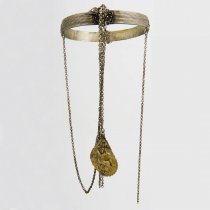A refugee heirloom in “Russian style”
Icon of the Last Judgement.
18th century.
BXM 10617
According to the Cyrillic inscription on the top border, the icon illustrates God’s Last Judgement and Christ’s Second Coming. In the upper part of the representation are depicted heavenly forces preparing for the terrible event: in the centre is shown the Father blessing the Son; on the left, Saints Constantine and Helene converse with each other, while on the right, Archangel Michael instructs the orders of angels. The central part of the representation is dominated by Christ in Glory, flanked by the Virgin and Saint John the Baptist.At His feet are portrayed Adam and Eve, whereas on the side, at a lower level, are shown apostles and saints. Beneath Christ,between two angels, lie the Cross and the instruments of the Passion,and immediately below takes place the weighing of souls (psychostasia). A long serpent with its head at Adam’s feet and his tail reaching the depths of Hades bears inscriptions on its body referring to the sins of those who are to be judged. To the left of the snake, the Apostle Peter unlocks the gate of Paradise for the righteous, who enter and then ascend into heaven. To the right of the snake, the Apostle Paul forces the sinners towards Hades, pointing at the Judge. The realm of the Underworld occupies the right end and the entire lower part of the representation. Below are depicted the sinners in a row, bound up in chains, led to the jaws of Hell, and immediately underneath, in the icon’s lower zone, unfold scenes from the punishments they undergo. The whole representation is surrounded by didactic and explanatory texts, all written in the Cyrillic script.
The icon was painted in a Russian workshop in the Vladimir region. Its exact Asia Minor provenience has not been documented; nor are we aware of how the object was found in Asia Minor. We do know, however, that from the 16th century onwards, a large number of Russian icons reached the southern Orthodox countries, either as donations of Russian officials, or as purchases of the Orthodox who visited Russia or commissioned works in Russian workshops.
Georgios Soteriou received the icon from the Asia Minor Refugee Heirlooms Committee on May 19 1927, accompanied by a proof of receipt, and put it on display in 1930 in the left wing of the “Villa Ilissia” courtyard, in a room where he had brought together works typical of “Foreign Medieval Icon Painting”. The icon remained there until the 1990s, when the room was no longer used for exhibition purposes. It was transferred to the Museum’s storeroom, and from there, to the new permanent exhibition in 2010. It is one of the five Russian icons kept as refugee heirlooms at the Byzantine and Christian Museum.



.jpg)
.jpg)
.jpg)
.jpg)
.jpg)
 Purple Gospel
Purple Gospel .jpg) The double-sided icon from Tuzla
The double-sided icon from Tuzla .jpg) An emblematic refugee “relic”
An emblematic refugee “relic”  A byzantine Hodegetria
A byzantine Hodegetria  An Evangelistary from Trebizond
An Evangelistary from Trebizond .jpg) A significant Palaeologan work
A significant Palaeologan work  Tetraevangelion from Adrianople
Tetraevangelion from Adrianople .jpg) A Cretan icon from Eastern Thrace
A Cretan icon from Eastern Thrace .jpg) “Joined in matrimony”
“Joined in matrimony”  A peculiar neckband
A peculiar neckband  Fragmented memory
Fragmented memory .jpg) Zumzud, the pilgrim
Zumzud, the pilgrim .jpg) A refugee heirloom in “Russian style”
A refugee heirloom in “Russian style” .jpg) An unusual “icon” from Cappadocia
An unusual “icon” from Cappadocia .jpg) "He (the Lord) keeps all their bones …" (Psalm 33: 21)
"He (the Lord) keeps all their bones …" (Psalm 33: 21) .jpg) A Karamanli icon
A Karamanli icon 



